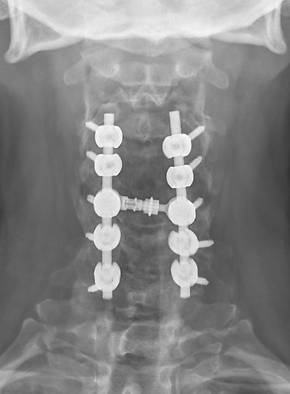
Posterior Cervical Fusion
What is a Posterior Cervical Fusion?
A posterior cervical fusion is a procedure to fuse vertebra(e) in the cervical spine. It is often accompanied by a "laminectomy" or "decompression" to relieve pressure on the spinal cord.
Screws are placed into the bones of the cervical spine, and those screws are joined by rods on either side. Bone graft is placed on either side of the spine to make the vertebrae fuse together.
A posterior cervical fusion is an "open procedure," however Dr. Bjerke uses all techniques possible to minimize damage to the muscles and soft tissues in the neck. Electrical impulses in the spinal cord and nerves are monitored during the case to prevent damage. A surgical microscope is used to carefully protect all nerves and arteries in the neck. You will be asked to wear a collar after surgery to prevent motion in the neck and ensure that the vertebrae heal properly.
The recovery involves immobilization in a neck brace for typically 6 weeks, followed by physical therapy. Patients are asked not to remove the collar except for showering, and to avoid lifting over 10 pounds during those weeks. Light duty working is allowed after 1 to 2 weeks, after pain medicine is no longer needed.
In some cases, a Cervical Laminoplasty may be performed. This is a motion-preserving technique, but is not recommended for all patients undergoing posterior cervical spine surgery. For more information, see Cervical Laminoplasty.
Right: xrays after an posterior decompression and fusion procedure performed by Dr. Bjerke. Screws are see in the C3 through C7 vertebrae, which are connected by rods.

